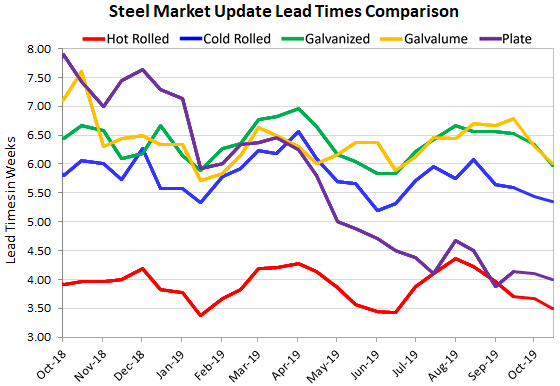SMU Data and Models

Steel Mill Lead Times: Still Getting Shorter
Written by Tim Triplett
October 27, 2019
Mill lead times for flat rolled products continued to shorten slightly over the past few weeks. The average lead time for hot rolled is now down to three and a half weeks, cold rolled is less than five and a half weeks and coated steels are just six weeks. Plate lead times remain around four weeks, according to data gathered this past week by Steel Market Update. It should be noted, however, that SMU gathered this data prior to the $40 price increase announced by the mills later in the week.
Lead times for steel delivery are a measure of demand at the mill level. The shorter the lead time, the less busy the mills, and the more likely they are to discount prices.
Hot rolled lead times now average 3.50 weeks, shortened from 3.67 weeks in early October. The average cold rolled lead time has dipped to 5.35 weeks from 5.44 weeks. The average lead time for galvanized has shortened to 5.97 from 6.33 weeks, while the lead time for spot orders of Galvalume is down to 6.00 weeks. Lead times for spot orders of plate steel have also declined to an average of 4.00 weeks. All lead times are shorter than they were at this time last year.
“Lead times are a mixed bag with some shorter than normal and others longer,” said one service center executive. “Lead times for cold rolled and coated are fine, but hot rolled is dragging everything down,” added another.

Note: These lead times are based on the average from manufacturers and steel service centers who participated in this week’s SMU market trends analysis. Our lead times do not predict what any individual may get from any specific mill supplier. Look to your mill rep for actual lead times. Our lead times are meant only to identify trends and changes in the marketplace. To see an interactive history of our Steel Mill Lead Times data, visit our website here.

Tim Triplett
Read more from Tim TriplettLatest in SMU Data and Models

SMU’s June at a glance
A look at SMU data for the month of June.

SMU Survey: Buyers’ Sentiment rebounds from multi-year low
Both of SMU’s Steel Buyers’ Sentiment Indices edged higher this week. Current Sentiment rebounded from a near five-year low, while Future Sentiment rose to a two-month high

SMU flat-rolled market survey results now available
SMU’s latest steel buyers market survey results are now available on our website to all premium members.

SMU Survey: Sheet lead times pull back after early-June blip, plate holds
Following the uptick seen two weeks ago, lead times eased this week for all four sheet products tracked by SMU, while plate lead times held steady, according to this week’s market survey.

SMU Survey: Pricing power abruptly shifts to steel buyers
The majority of steel buyers responding to our latest market survey say domestic mills are more willing to talk price on sheet and plate products than they were earlier this month. Sheet negotiation rates rebounded across the board compared to early June, while our plate negotiation rate hit a full 100%.
